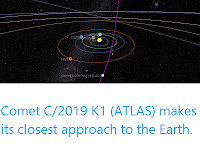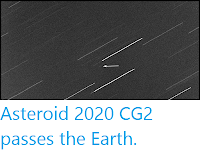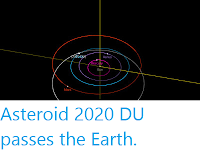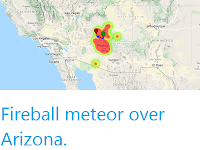Asteroid 2020 DD3 passed by the Earth at a distance of about 1 017 000
km (2.65 times the average distance between the Earth and the Moon, or
0.68% of the distance between the Earth and the Sun), slightly before 10.05 am
GMT on Friday 21 February 2020. There was no danger of
the asteroid hitting us, though were it to do so it would not have
presented a significant threat. 2020 DD3 has an estimated
equivalent
diameter of 20-62 m (i.e. it is estimated that a spherical object
with
the same volume would be 20-62 m in diameter), and an object of this
size
would be expected to explode in
an airburst (an explosion caused by superheating from friction with the
Earth's atmosphere, which is greater than that caused by simply
falling, due to the orbital momentum of the asteroid) in the atmosphere between 23 and 5 km above the ground, with only fragmentary material
reaching the Earth's surface.
The calculated orbit of 2020 DD3. JPL Small Body Database.
2020 DD3 was discovered on 24 February 2020 (three days after its closest approach to the Earth) by the Atlas MLO Telescope at Mauna Loa Observatory in Hawaii. The designation 2020 DD3 implies that the asteroid was the 76th object (object D3 -
in numbering asteroids the letters A-Z, excluding I, are assigned
numbers from 1 to 25, so that D3 = (24 x 3) + 4 = 76) discovered in the second half of February 2020 (period 2020 D).
2020 DD3 has a 772 day (2.11 year) orbital period and an eccentric orbit
tilted at an angle of 5.60° to the plane of the Solar System, which
takes it from 0.56 AU from the Sun (i.e. 56% of he average distance at
which the Earth orbits the Sun, insdie the orbit of the planet Venus) to 2.74 AU from the Sun (i.e. 274% of
the
average distance at which the Earth orbits the Sun, and considerably outside the orbit of the planet Mars). It is therefore
classed as an
Apollo Group Asteroid (an asteroid that is on average further from the
Sun than the Earth, but which does get closer). This
means that close
encounters between the asteroid and Earth occasionally occur, with the next predicted for March 2058.
2020 DD3 also
has frequent close encounters with the planets Venus, which it is next predicted to
pass in January 2094, and Mars, which it is predicted to pass in March 2058. Asteroids
which make close passes to multiple planets are considered to be in
unstable orbits, and are often eventually knocked out of these orbits by
these encounters, either being knocked onto a new, more stable orbit,
dropped into the Sun, knocked out of the Solar System or occasionally
colliding with a planet.
See also...
Follow Sciency Thoughts on Facebook.







